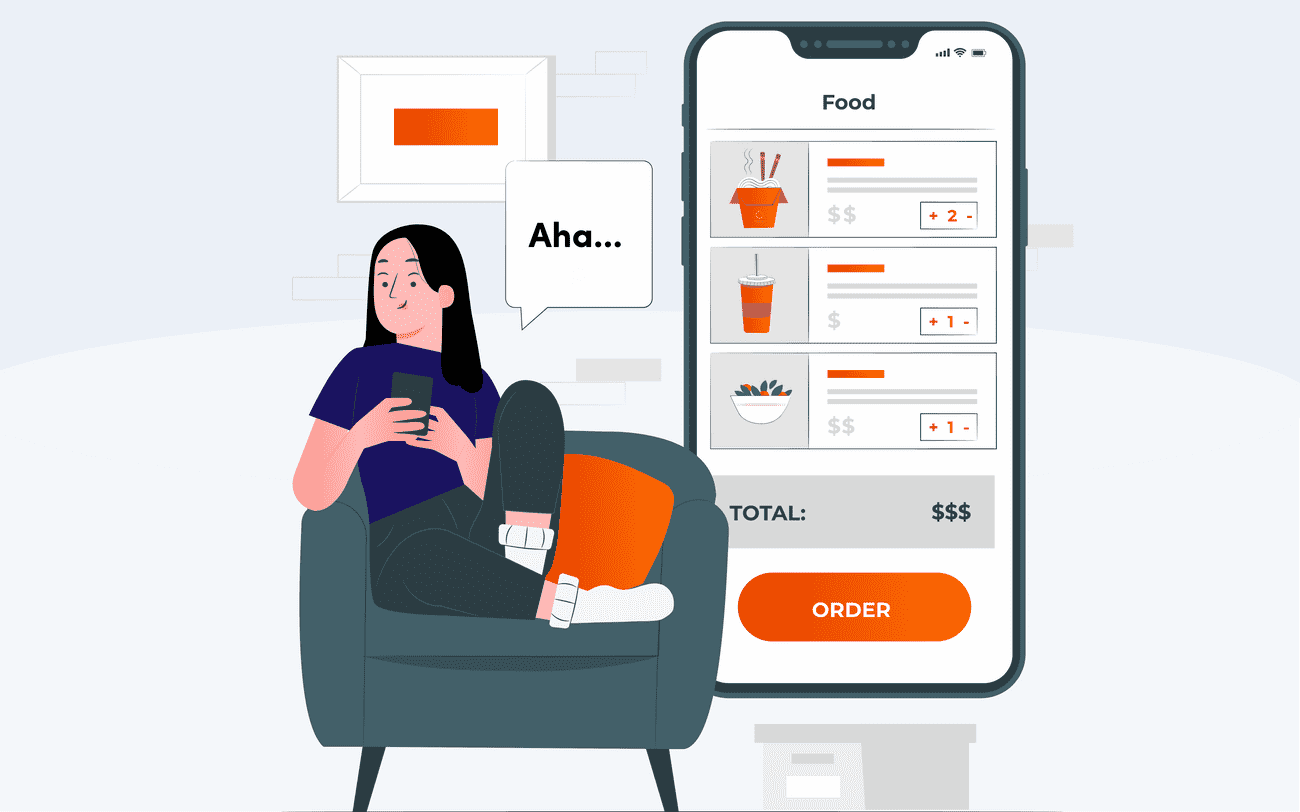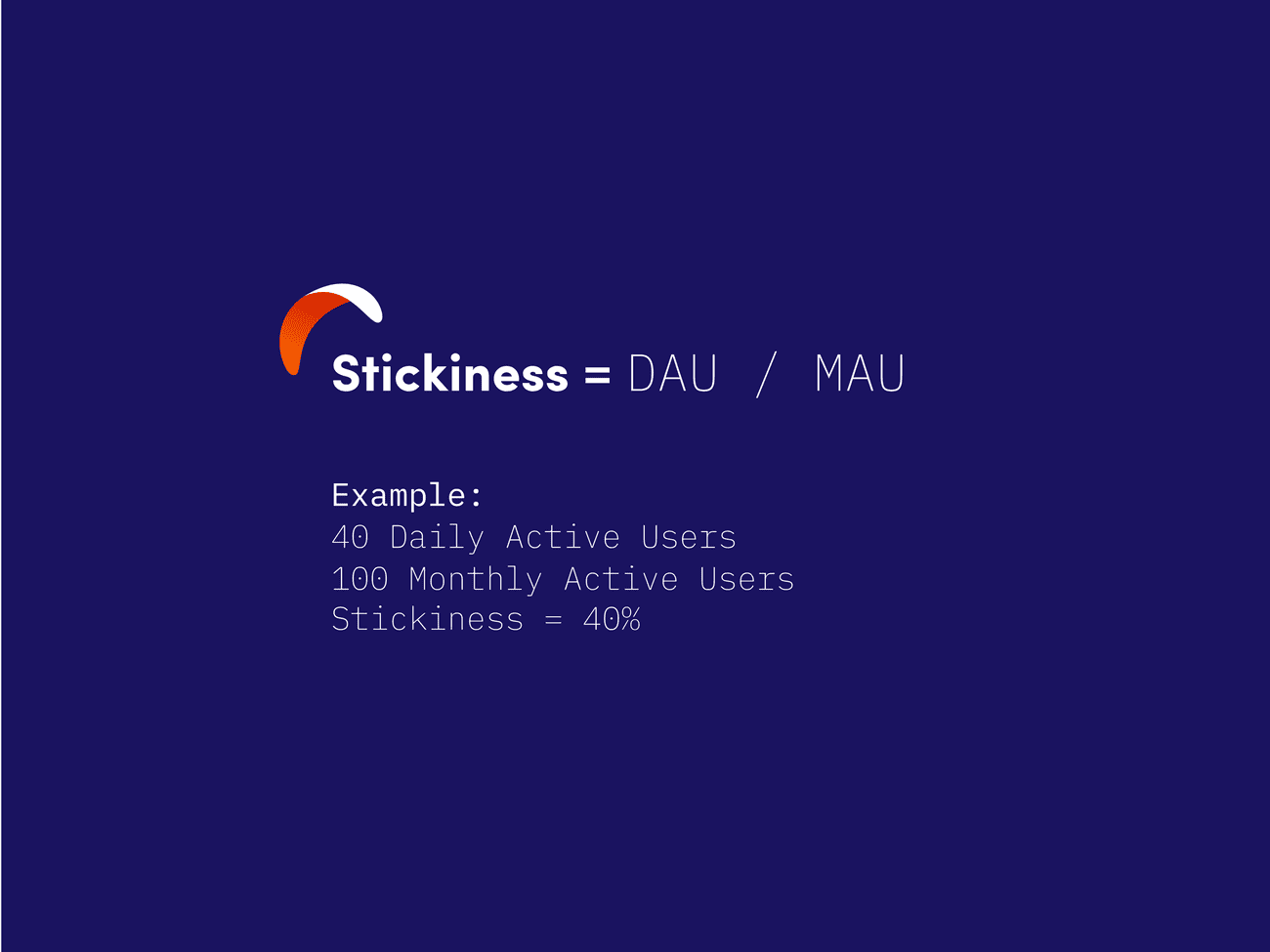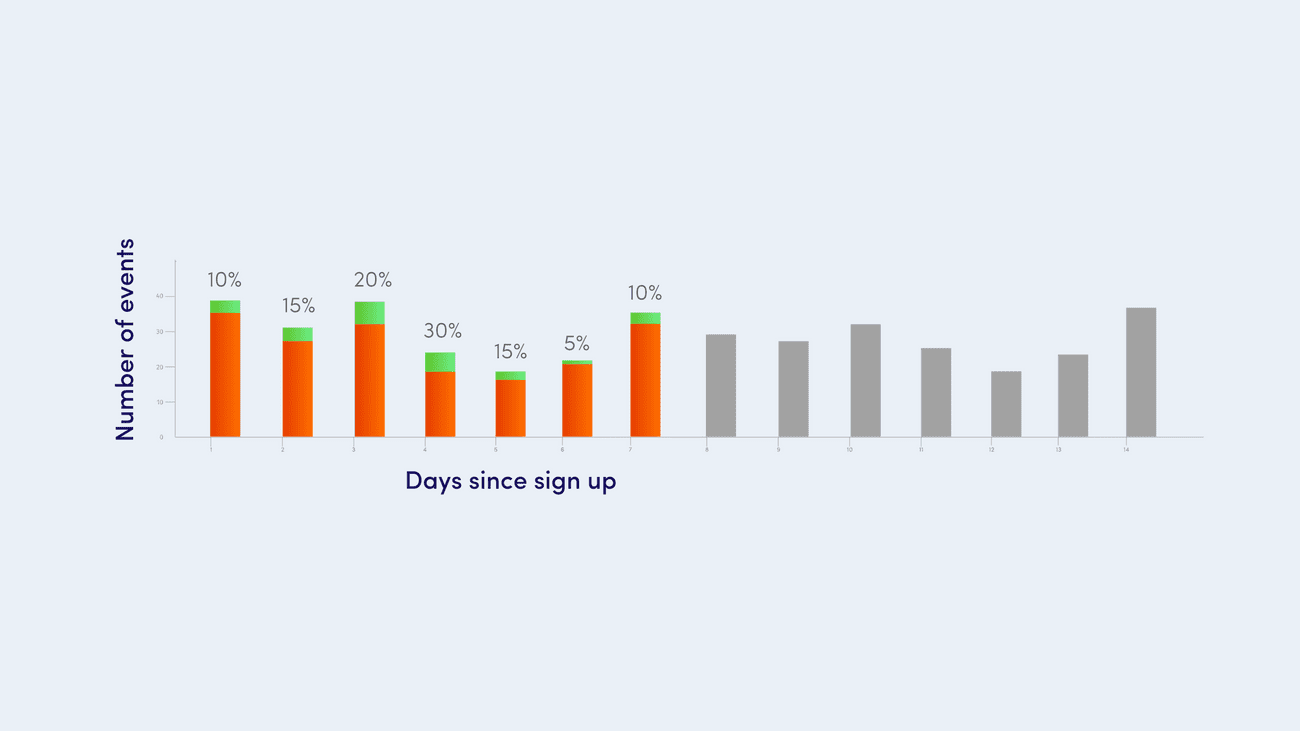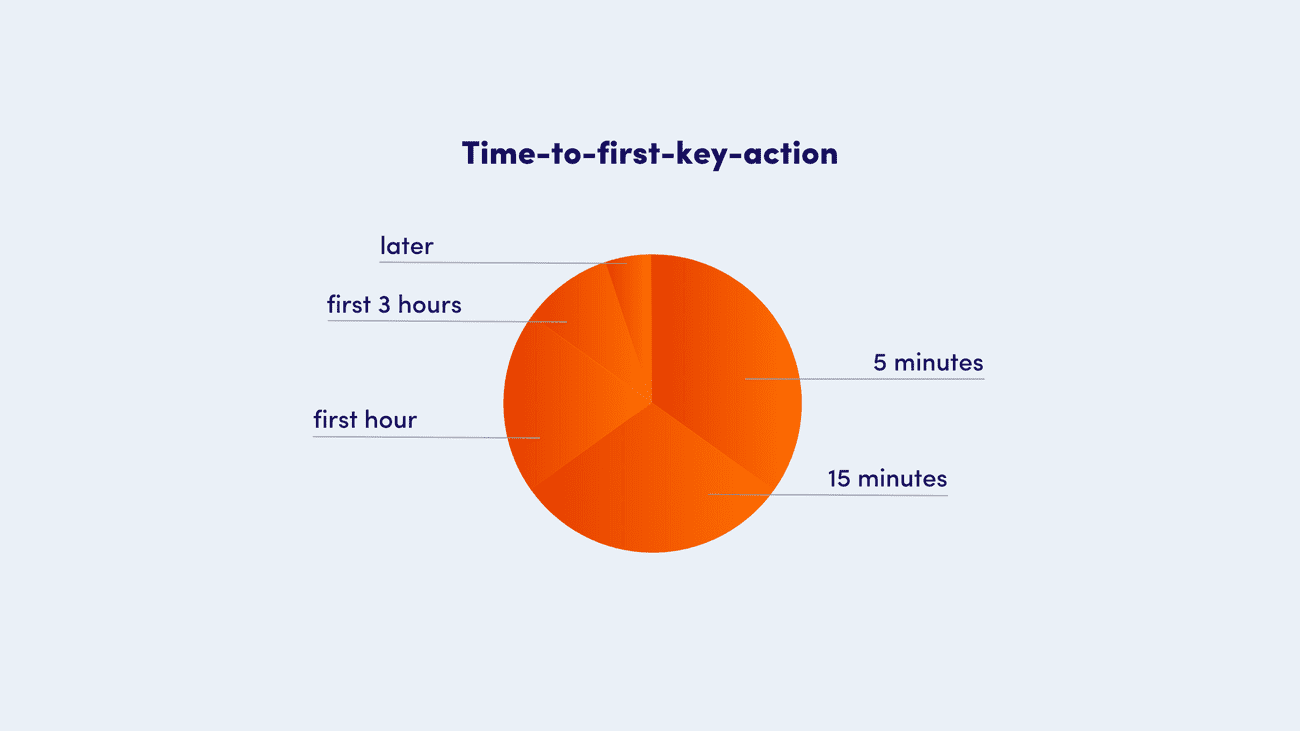User Engagement Metrics every successful SaaS should measure
When running a SaaS business, very often we assume that the most important information for us is how many users we have in our database. On the one hand, this is obvious, but on the other hand, there is a question if the number of users is what allows us to measure our results within specific time period.
The other important question is whether these people are active users or just have in your app so-called dead accounts. However, digital marketing specialists know that having a large group of users is not always the answer to business growth problems.
Imagine a situation where you have X million monthly active users, while your direct competitors have only had a few thousands so far. After some time, however, it turns out that your direct competitor has many more users in the application. So, the question arises – what is the reason for such a situation?
The key to success is not only how many users are using the application, but also how users engage with the app and particular features. To know what the situation is, the best SaaS businesses focus their attention on specific engagement metrics, so they can measure relevant user behavior, which in turn allows them to create a huge number of loyal customers. This leads to getting more business growth.
It doesn't matter if you are promoting mobile apps or running an ecommerce website. If you want to increase customer loyalty, even the best content marketing strategy or tools like Net Promoter Score is no substitute for taking a deliberate approach to how your app is really used by users.
Of course, as we observe the behavior of our users, we should also naturally look at whether, how and when our customers make payments for services. This is also a crucial indicator concerning engagement, but today we would like to focus primarily on issues related to the use of the application itself. Don't worry, we will definitely cover the topic of finance in a separate text soon.
So, in this article, we'll cover a selection of user engagement metrics that will help you concentrate your strategic and marketing efforts on key metrics that significantly boost customer satisfaction score and customer loyalty.
We're going to cover the following metrics:
- DAU, WAU, MAU
- Product Adoption
- Stickiness
- Feature adoption
- Core User Actions
- Session length & frequency
- First week engagement
- Time-to-first-key-action
DAU (Daily active users), WAU (Weekly Active Users), MAU (Monthly active users)
At first glance, these abbreviations may not say much, however, behind them lies something critical for sustaining business. Knowing these metrics can really improve user engagement and help you use other factors that will show you the bigger picture.
The above abbreviations stand for Daily, Weekly and Monthly Active Users. Each of them refers to the unique number of users within a given period.
DAU means the number of your users who performed some actions in the app each day.
WAU represents the number of people who performed some actions in the app during a week.
MAU represents the number of users who performed some actions during a month.
Why are these engagement metrics important?
DAU and MAU are among the important metrics because they highlight the overall health of your business. You can see how much interest there is in the product, and you can also use them to determine other significant parameters that will help you go much deeper into analytics.
What should you be doing to make sure you're measuring these metrics the right way?
Measuring customer engagement through engagement metrics works when we know what users we're talking about. Namely, you need to know how you define an Active User and then measure it. Is it someone who created an account in your app, or someone who performed some specific action? Defining and standardizing your nomenclature will help you make sure you're measuring the same things every time, so the results will be consistent.
Product Adoption – customer engagement metrics that concentrate on what matters
When customers look for solutions, they are often driven by the specific problem they intend to solve. For example, if someone feels it's a challenge for them to simultaneously maintain communication channels across several social media profiles, that person will look for a solution to effectively manage the work.
If you are eager to learn more about delivering new features that customers actually need, check out the article of our partners on customer satisfaction.
Once a user, after discovering your product, starts using some functionality, he or she adopts that functionality, that is, starts using it with some regularity. We call this moment Product Adoption, and it's one of the popular user engagement metrics.
It is worth remembering that the word adoption can be defined differently in different industries because in each case required feature usage can mean something different.
For example, if we take a look at such applications as Facebook or TikTok, we will notice that there may be several moments in them that we consider as product adoption. We can define it as installing the application, creating an account, or even reaching a specific time user spends in the app. The thing is that you need to decide which user actions indicate that users are getting the value they should be getting.
What does it give you?
When new users begin using your product with some regularity, this means that they start to see more and more value in such a solution. Therefore, monitoring these important engagement metrics allows you to stay up to date and make decisions about which functionalities are most important. This approach to monitoring the app lets you turn your user base into a place where more customers will appear.
How should you measure this engagement metric the right way?
Deciding what exactly we consider adoption is not a simple thing. To know that we are dealing with an AHA moment (a customer starts using the product because they see value), we need to use something that clearly shows us that the user is getting value from the application.
It may seem like page views are a good example of a metric to evaluate adoption, but it's not really an engagement metric that will show us that the user is getting value. A much more important thing is to focus on measuring people who perform certain actions in the app that actually tell us something about retention and ongoing usage.
Stickiness – feature usage metrics that show you how many users engage in your app regularly
Quite a few SaaS businesses pay attention to how many new users sign up for the trial and how many accounts are currently open in the system. However, sometimes they don't check how often, after opening an account, existing customers return to the system to continue using the application.
It's worthwhile for you to measure what's called Stickiness, or how sticky your solution is. A sticky product is one that engages customers and causes them to become more involved in using the functionality, and thus use the solution more often.
Stickiness is among the most crucial metrics to track because it shows you how many users regularly use your solution. Customers who regularly return to your app are the most engaged and see the value of your solution.
Here, you can use the knowledge from the previous section (DAU / MAU) and measure this ratio using the following formula.
For example, if you see that there are 40 Daily Active Users in your application, and the number of Monthly Active Users is 100, your Stickiness is 40%. This means that over the course of 30 days, an average user spends 40% of their time in your app.
Why is Stickiness one of the important user engagement metrics?
When you create a SaaS business, it doesn't really matter how well your sales are going if customers leave after a while. If users stop using your solution, you're performing a Sisyphean task.
You need to convert all new users into satisfied customers, as this is something that lets your business grow. Monitoring stickiness is something that the best customer feedback survey can't replace.
The more often users use your app, the more chances increase that they will take advantage of additional things you offer, such as upgrading to a higher plan or buying some additional functionality.
Monitoring this type of user activity allows you to not only extend the customer lifetime, but also see the customer journey more clearly and reach a lower churn rate.
This is also a valuable metric for Product Managers, as they can look at how users are using the app and which features are worth changing or improving to increase user engagement. In addition, knowing how much time users use the app also allows Founders to monitor average session duration to make better decisions about marketing strategies.
How do you measure stickiness the precise way?
Every business has some engagement metrics that, when used, translate into the value that users receive. In other words, in every application, there is a functionality that needs to be used in order for users to feel that the solution is worth using. When we approach stickiness properly, it is a metric that adds a ton of valuable information to other user engagement metrics.
Therefore, in the first place, it is worth considering what is the core feature that users should use regularly. So take a look at your functionalities and consider which ones are important from a business model perspective.
It is also critical for you to remember that no new user is DAU until a certain point and should not be counted for stickiness. Such counting can lead to distorted statistics.
Feature Adoption – how to monitor user engagement in particular features
Acquiring new engaged customers is an essential part of a growing SaaS business. At the same time, the healthiest businesses care about user retention and the ongoing delivery of value to users. In order for new users to gain enough value and feel that using the solution makes sense, they need to take advantage of the right number of features in the software.
Therefore, one of the most important strategies is to track users to get an idea of what features they are using. The more features users use, the more value they can feel, so your job is to measure what is called Feature Adoption.
Why is it important to monitor this type of engagement metrics?
When we add any further functionality in our solution, we create another opportunity for the customers to feel that they are getting value by using your application. If, on the other hand, there are some features in the app that the customers don't use, they may conclude that maybe the solution isn't that necessary for them after all.
Therefore, to increase the number of satisfied customers in the user base, the best customer engagement strategy assumes that the customer will notice these things and use them, which you can monitor using specific metrics.
What to look at through Feature Adoption?
On the surface, measuring Feature adoption may seem easy. After all, we're looking at whether or not users launch certain features. However, this is not a precise approach that will allow you to use user engagement metrics in the right way.
App or site engagement is related to how users engage in your solution, and in the case of feature adoption, it's supposed to show how they use features. To gain a proper perspective on adoption, it is helpful to look at it from several angles:
- Breadth of adoption – Look at how widely a feature is used in your user base. In other words, how many users are adopting this part of the solution. Is it numerous people or maybe a small group of users? Looking at this parameter will give you an idea of how attractive your feature is.
- Depth of adoption – One indicator of good user engagement in an app is how often users interact with particular features. When you see users using a feature frequently, it's a signal to you that the feature is useful and people see value in it.
- Time to adopt – This is a user engagement metric that shows how quickly users start using a feature from the moment they first interact with it. If users wait a few days or weeks, this could be a signal to you that there is something standing in their way. Maybe
- Duration of adoption – It often happens that right after implementing some functionality in an application, users start using it, but with time their enthusiasm wanes. It may mean that some functionality is not useful enough or access to it is difficult for some reason.
Therefore, one of the user engagement metrics to track is duration of adoption. This is the time it takes users to use a functionality from the moment they start using it.
Core User Actions – actions that are most important to your business
Every business needs customers, and every application needs users. So, it is true that the development of user base is a critical element. However, you can't forget about what these users do, or rather what they should do in the application to exploit its potential.
Therefore, every well-growing SaaS business focuses on monitoring something called Core User Action. This is the action that forms the basis of your solution. The most important application that is the core of all other functionalities.
For example, the core functionality of Twitter users is tweeting. For Pinterest, such a feature is pinning. YouTube, on the other hand, wouldn't exist if users didn't upload video content. Facebook, on the other hand, would not grow if users did not add new people as friends.
In addition to the main functionality, there are usually other supporting functionalities in apps that are also important to users. However, they are not something that a new user would definitely look for.
So, to properly develop user engagement, first think about what the core user action is in your app, and then track weekly active users who complete these actions.
Session length & frequency – user engagement metrics that help you discover where problems lie within your app
Daily active users spend a certain amount of time in the app usually browsing multiple pages per session. What we are interested in is how much time these people spend in the app during a single session.
Let's say a new user came to you through one of your email marketing campaigns. This person turns on the app after installation, scrolls inside the menu, clicks a few buttons, and then leaves. The time such a customer spent in your app is the session length.
If you take the sum of all session lengths and divide by the number of sessions in a given period, you get an Average session length. With this indicator it is much easier to measure user engagement.
How do you calculate Session length?
Measuring session duration is simple. You need to know when the user started the session (started the application or visited your website) and when he/she finished. What is important here is how these user actions work in your solution.
For example, if a customer clicks the "Quit" button after using the application or logs out due to inactivity, we can consider the session ended.
We usually measure this indicator in minutes and report it as a specific time period. If a user started using an application or functionality at 11:15 and finished at 11:23, the Session length is 8 minutes.
Why is Session length important for measuring engagement?
No robustly growing app is complete without Daily active users. However, in order to talk about user engagement and user engagement metrics, we need to have a situation where users are spending a reasonable amount of time in the app.
The session length is an indicator that supports SaaS businesses in determining the average session duration, which allows you to check whether you goals for the application or particular features have been achieved.
How to measure customer engagement with Session length the right way?
It is important when measuring user engagement not to make certain mistakes that can lead to wrong conclusions.
The first point is that a long session time does not always mean that users are using the application and are satisfied. You need to look at the different elements of your solution and consider whether this session length means that the user feels value, or whether it could be because they don't know much about what to do.
When measuring this metric, consider data such as industry benchmarks and other metrics to have a good baseline. If you know that typically users spend a certain amount of time in a mobile app, it will be easier for you to know if your results meet industry standards.
In general, no user engagement metric should be evaluated in isolation. So, remember not to take session length as the sole determinant of whether there is user engagement in your app. Look at other engagement metrics and then draw conclusions.
One final thing to note is that the length of the session itself is not a total indicator of whether things are going as they should. Users have their own habits, and in different apps, sessions are often split into short activities.
As for Facebook or Instagram, for example, users visit the app several times throughout the day to check notifications and new posts.
Session frequency – how often users come back
Another engagement indicator to look at is Session frequency, which is the time period between consecutive sessions. This is a helpful indicator because it shows how long it takes for customers to return to your app before they take another action. With this indicator, you can get an idea of how loyal your customers are, as well as spot possible things that may stand in their way.
First week engagement – do people really feel the value?
SaaS business owners often pay attention to various user engagement metrics. However, they overlook one critical element - how much the user engages with the app in the first week of use.
If the user doesn't engage in the first week of installing the solution, there's a good chance they won't engage later. So, we may have a problem with a significant bounce rate.
Lack of user activity in the first week can also be a signal to us that something is going on. For example, our onboarding process may not be clear to the customer, or using the application itself is not intuitive enough for him.
What should you look at when you lose a lot of customers in the first week?
It's worth analyzing the customer journey from the first moment they started using the application. Is your onboarding process simple? Is there anything that might stand in the way or be incomprehensible to the customer? Go through the process yourself and analyze each step.
Make sure your solution is understood by the customer. Even if the onboarding process itself is ok, you may find that there are difficulties at later stages. You can analyze all the steps of the customer, but also use in-app surveys to find out the customer's observations. After all, their experience and perspective is the most important thing.
The cost structure of your app can also impact users. So, it's worth looking at whether your pricing is appropriate.
The last thing to look at is the type of customer service in your app. Undoubtedly, solid and glassy-eyed support that is able to identify obstacles on the customer side can have a significant impact on how users will engage in the first week and beyond. So, make sure you have the right people with the appropriate skills. This can impact customer lifecycle and conversion rates in your business.
Time-to-first-key-action
All the metrics you monitor should help you get a better feel for user activity. When a user interacts with your app, they make decisions regarding when they will engage in using your features.
You can't increase customers loyalty if your active users don't engage in your app. To use a feature, they simply need to start. If you find that your users are taking a long time to transition to using the functionality, it could mean that something is wrong. So, it's worth measuring this metric - how long it takes your users to adopt the functionality. Additionally, the longer a user waits before adopting a feature, the harder it is for them to adopt later.
Summary
The most growing SaaS businesses make sure that user engagement is measured by specific, outcome-driven engagement metrics. The metrics listed above should be on the must-have list of every solidly growing business, as they can really help you make better informed decisions and boost customer satisfaction in your SaaS. We also found a great article if you are wondering how to build a highly engaged online community in the first place.
More on the topic of tracking important SaaS metrics you will find im my next blogpost on 6 things you should monitor to ensure your SaaS is healthy
BONUS: Tools that will help you track users engagement metrics
We have compiled a short list of really useful tools that will help you measure user engagement in many dimensions. Below you will find the most interesting applications:
- Pendo: https://www.pendo.io
- Appcues: https://www.appcues.com
- Heap: https://heap.io
- Amplitude: https://amplitude.com
- UserIQ: https://www.useriq.com
- Mixpanel: https://mixpanel.com/home/
- Google Analytics: https://analytics.google.com









